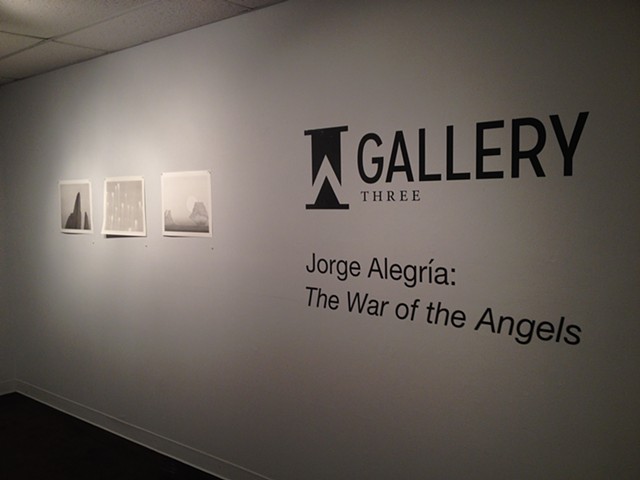HEAVEN: The War of the Angels
Jorge Alegría’s graphite drawings are as far from black and white as you can get without introducing color. He works gray for all of the variation he can get from it, practically developing a full spectrum of tone. He uses those tones to do the same thing with his images. Alegría images everything from crisp sharp-focused illuminated rock forms to mists that veil mysterious and ambiguous presences. Exactly how he pulls it off is as mysterious as the images he chooses. There is no trace of “gestural energy” as in more traditional drawings. That energy has been subsumed in the way he manipulates the powdered graphite, it’s there, but on the scale of the particulates of dust. It’s like drawing, but with the molecular resolution of a photograph, made by a hand with a deft sensitivity to touch. For all the information he imprints on the paper the surface remains pristine and free of any burnishing or incision. Leaving it much like pictures on the page of a scientific periodical, science fiction magazine, or naturalist guide …the stuff Alegría has visually fed on since he was a teenager. While all of these are plainly observable qualities in Alegría’s drawings, they fuse together to create an effect that is greater than the sum of its parts. At once, the drawings are dark, mysterious, and alien. Looking at Alegría’s drawings feels like the excitement of discovery. And yet, in that self-possessed and print-like delivery there is something cool and tinged with distance. That’s not to say that his compositions are static. On the contrary, there is deliberate concert; Alegría pairs stable vertical and horizontal edges with delicate diagonals, and even goes so far to show us a “comet” crashing across the page as it descends. But there is no motion blurring, as if it were photographed with a technology far more perfect than ours and perhaps as fictional and alien as the image captured. We see something frozen in time for the benefit of our observation. The image is as full of information, as if gathered by the scrutinizing and examining eyes of a scientist, but processed with the neutral and placid mind of a Buddhist monk.
David Hill, 2015
